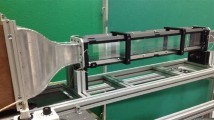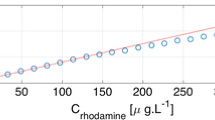Abstract
The development and breaking of Kelvin–Helmholtz waves is one of the primary causes of mixing in many geophysical and engineering flows with layers of fluids having different densities and horizontal velocities. Although this phenomenon was extensively studied in the field, a complete description can be experimentally obtained only by the use of image analysis techniques that are applicable only in laboratory experiments. The particular nature of the flow, especially before the development of the waves when the flow is parallel but in opposite direction, makes the application of the classical image velocimetry techniques non-trivial. With this in mind, a stably stratified shear flow was reproduced in the laboratory by means of a tilting tank. The velocity and density fields were measured simultaneously with multipoint time-resolved techniques during the formation and development of the Kelvin–Helmholtz waves. A novel particle tracking procedure is proposed that includes the stretching of the acquired images in the direction orthogonal to the main motion. Tests on synthetic images show a meaningful improvement in the effectiveness of particle tracking when using the proposed technique. Laser-Induced Fluorescence (LIF) data have been acquired by a second camera, equipped with a band-pass filter in order to measure only the fluoresced light. Particle Tracking Velocimetry (PTV) and LIF data have been referenced to the same frame by a registration procedure based on an affine transformation. In the range of the parameters investigated during the experiments, the evolution of the interface thickness and sharpness scales with the advective time scale. The analysis of the space–time evolution of the longitudinal statistics gives a comprehensive picture of the development and breaking of the waves.










Similar content being viewed by others
References
Atsavapranee P, Gharib M (1997) Structures in stratified plane mixing layers and the effect of cross-shear. J Fluid Mech 342:53–86
Caulfield CP, Peltier WR (2000) The anatomy of the mixing transition in homogeneous and stratified free shear layers. J Fluid Mech 413:1–47
De Silva IPD, Fernando HJS, Eaton F, Hebert D (1996) Evolution of Kelvin–Helmholtz billows in nature and laboratory. Earth Planet Sci Lett 143:217–231
Defina A, Lanzoni S, Susin FM (1999) Stability of a stratified viscous shear flow in a tilted tube. Phys Fluids 11(2):344–355
Haigh SP, Lawrence GA (1999) Symmetric and nonsymmetric Hölmböe instabilities in an inviscid flow. Phys Fluids 11(6):1459–1468
Howard LN (1961) Note on a paper of John W. Miles. J Fluid Mech 10:512–512
McDougall TJ (1979) On the elimination of the refractive index variations in turbulent density stratified liquid flows. J Fluid Mech 98:83–96
Miles JW (1961) On the stability of heterogeneous shear flows. J Fluid Mech 10:496–508
Monti P, Fernando HJS, Princevac M, Chan WC, Kowalewski TA, Pardyjak ER (2002) Observations of flow and turbulence in the nocturnal boundary layer over a slope. J Atmos Sci 59(17):2513–2534
Monti P, Leuzzi G (1996) A closure to derive a three-dimensional well-mixed trajectory model for non-Gaussian, inhomogeneous turbulence. Boundary-Layer Meteorol 80:311–331
Monti P, Querzoli G, Cenedese A, Piccinini S (2007) Mixing properties of a stably stratified parallel shear layer. Phys. Fluids 19(085104):1–9
Peltier WR, Caulfield CP (2003) Mixing efficiency in stratified shear flows. Annu Rev Fluid Mech 35:135–167
Querzoli G (1996) A Lagrangian study of particle dispersion in the unstable boundary layer. Atmos Environ 30:282–291
Smyth WD, Moum JN (2000) Length scales of turbulence in stably stratified mixing layers. Phys Fluids 12(6):1327–1342
Staquet C (2000) Mixing in a stably stratified shear layer: two- and three-dimensional numerical experiments. Fluid Dyn Res 27:367–404
Thorpe SA (1968) A method of producing a shear flow in a stratified fluid. J Fluid Mech 32:693–704
Troy CD, Koseff JR (2005) The generation and quantitative visualization of breaking internal waves. Exp Fluids 38:549–562
Woods JD (1968) Wave-induced shear instability in the summer thermocline. J Fluid Mech 32:791–800
Zitová B, Flusser J (2003) Image registration methods: a survey. Image Vis Comput 21:977–1000
Author information
Authors and Affiliations
Corresponding author
Rights and permissions
About this article
Cite this article
Querzoli, G., Monti, P. & Cenedese, A. Image analysis applied to the study of mixing in a stably stratified shear layer. Exp Fluids 45, 633–642 (2008). https://doi.org/10.1007/s00348-008-0520-6
Received:
Revised:
Accepted:
Published:
Issue Date:
DOI: https://doi.org/10.1007/s00348-008-0520-6




